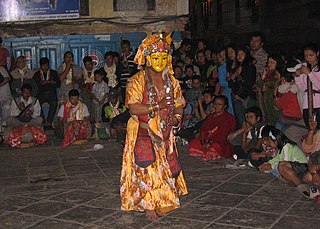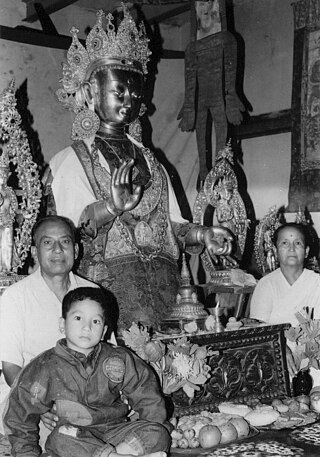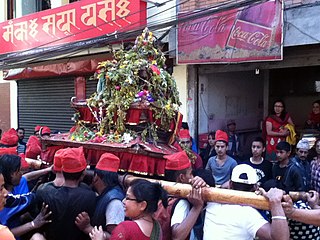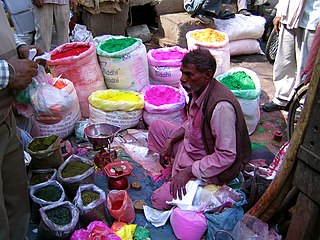A request that this article title be changed to Newar Hinduism is under discussion. Please do not move this article until the discussion is closed. |

Newa Hinduism is a form of Hinduism followed by the Newar people in Nepal. [1]
A request that this article title be changed to Newar Hinduism is under discussion. Please do not move this article until the discussion is closed. |

Newa Hinduism is a form of Hinduism followed by the Newar people in Nepal. [1]

Newar dance consists of sacred masked dance, religious dance without the use of masks known as Dyah Pyakhan, a dance performed as part of a ritual and meditation practice known as Chachaa Pyakhan (Newar : चचा प्याखं) (Charya Nritya in Sanskrit) and folk dance. There are also masked dance dramas known as Daboo Pyakhan which enact religious stories to the accompaniment of music. Masked dances are performed on stone dance platforms that exist at all major city squares. They are the highlight of religious festivals. Most dances are held annually while certain dances are performed once every 12 years. The performances are organized by dance societies in which membership is hereditary. The history of these traditional dances goes back centuries.[ citation needed ]
Newa Hinduism and Newa Buddhism share the festivals of each other. [2]
This day people go to Swyambhu and Chobar for worshiping. [3]
This day is the birthday of Sankhadhar Sakhwa who was the founder of Nepal Sambat.
This day people especially Kapali people worship Shiva. [4]
This day people eat Yomari. Especially Jyapu people they worship their communistic god. This day is also referred as Jyapu divas. [5]
This day is a main day of Bari people for performing Puja. [6]
The term "Asthami-thwa" means the 8th day of the month or even the 8th day of the sub-month before the full moon. This day Seto Machindranath is worshiped.
This is the starting day of the Hindu religious story "Swasthani" [7]
This day is one of the festivals celebrated by Solar calendar. Though it lies on Pohela(पोहेला) month of Nepal Sambat its accurate date is 1st Magh of Bikram Sambat. This day is also known as Maghe Sankranti.

Newar or Nepami, are the historical inhabitants of the Kathmandu Valley and its surrounding areas in Nepal and the creators of its historic heritage and civilisation. Newars form a linguistic and cultural community of primarily Indo-Aryan and Tibeto-Burman ethnicities following Hinduism and Buddhism with Nepal Bhasa as their common language. Newars have developed a division of labour and a sophisticated urban civilisation not seen elsewhere in the Himalayan foothills. Newars have continued their age-old traditions and practices and pride themselves as the true custodians of the religion, culture and civilisation of Nepal. Newars are known for their contributions to culture, art and literature, trade, agriculture and cuisine. Today, they consistently rank as the most economically and socially advanced community of Nepal, according to the annual Human Development Index published by UNDP. Nepal's 2011 census ranks them as the nation's sixth-largest ethnicity/community, with 1,321,933 Newars throughout the country.
Ranjitkar is one of the castes of Newar. The Newari caste system is divided according to profession. The Ranjitkar caste is concerned with the dyeing of clothes as well as other color related activities. The word "Ranjitkar" comes from Sanskrit origins crudely meaning "people concerned with colors" whereas the word "Chhipaa" is a Nepal Bhasa compound word which can be roughly translated as "color and allow to dry".

Newar Dance consists of the whole array of dances that are traditionally performed by Newars.

Lākhey is the dance of a demon in the carnival of God.
The Newas are well known for their lavish festivals. The word jatra is used for carnivals. Based on Nepalese calendar, Nepal Sambat, the different festivals are:

Tulādhar is a Nepali/Nepalese caste from the Newar community of the Kathmandu Valley in Nepal. The name Tuladhar is derived from the Sanskrit words "tula" and "dhar" (possessor), thus meaning scale-bearer or in general, merchant. Tuladhars belong to the Uray group which includes Kansakar, Tamrakar, Sthapit, Bania, Sindurakar, Selalik and other castes. They follow Newar Buddhism and speak Nepal Bhasa as a mother tongue.

Yomari, also called yamari, is a delicacy of the Newar community in Nepal. It is a steamed dumpling that consists of an external covering of rice flour with sweet fillings such as chaku and khuwa. The delicacy plays a very important role in Newa society, and is a key part of the festival of Yomari Punhi. According to some, the triangular shape of the Yamari is a symbolical representation of one half of the Shadkona, the symbol of Saraswati and wisdom.

Kirat Mundum, also known as Kiratism, or Kirati Mundum, is a folk religion that is indigenous to the Kirati ethnic groups of Nepal, Darjeeling and Sikkim, majorly practiced by Yakkha, Limbu, Sunuwar, Rai, Thami, Jirel, Hayu and Surel peoples in the north-eastern Indo subcontinent. The practice is also known as Kirat Veda, Kirat-Ko Veda or Kirat Ko Ved. According to some scholars, such as Tom Woodhatch, it is a blend of shamanism, animism, and Shaivism. It is practiced by about 3.1% of the Nepali population as of 2011.

Yomari Punhi is a Newari festival marking the end of the rice harvest. It takes place in November/December during the full moon day of Thinlā (थिंला), the second month in the lunar Nepal Era calendar.

Indra Jātrā, also known as Yenyā, is the biggest religious street festival in Kathmandu, Nepal. The celebrations consist of two events, Indra Jātrā and Kumāri Jātrā. Indra Jātrā is marked by masked dances of deities and demons, displays of sacred images and tableaus in honor of the deity Indra, the king of heaven. Kumāri Jātrā is the chariot procession of the living goddess Kumari.

Pāhān Charhe also known as Pāsā Charhe is one of the greatest religious festivals of the year in Nepal Mandala. It is celebrated with particular fervor in Kathmandu, and consists of a conglomeration of activities including parades, masked dances, horse racing and religious worship held over three days in different places.

Kachhalā is the first month in the Nepal Era calendar, the national lunar calendar of Nepal. The month corresponds to Kārtik in the Hindu lunar calendar and roughly matches November in the Gregorian calendar.

Thinlā is the second month in the Nepal Era calendar, the national lunar calendar of Nepal. The month corresponds to Margashirsha (मार्गशीर्ष) in the Hindu lunar calendar and roughly matches December in the Gregorian calendar.

Pwanhelā is the third month in the Nepal Era calendar, the national lunar calendar of Nepal. The month corresponds to Pausha (पौष) in the Hindu lunar calendar and roughly matches January in the Gregorian calendar.

Chilā is the fifth month in the Nepal Era calendar, the national lunar calendar of Nepal. The month coincides with Phalguna (फागुन) in the Hindu lunar calendar and March in the Gregorian calendar.

Dilā is the ninth month in the Nepal Era calendar, the national lunar calendar of Nepal. The month coincides with Āsāṛh (आषाढ) in the Hindu lunar calendar and July in the Gregorian calendar.

Yanlā is the eleventh month in the Nepal Era calendar, the national lunar calendar of Nepal. The month coincides with Bhadrapada (भाद्रपद) in the Hindu lunar calendar and September in the Gregorian calendar.

Kaulā is the twelfth month in the Nepal Era calendar, the national lunar calendar of Nepal. The month coincides with Ashvin (अश्विन्) in the Hindu lunar calendar and October in the Gregorian calendar.

Dance is a performing art form consisting of purposefully selected sequences of human movement. Dance (Nepali: नृत्य/ नाच) in Nepal comprises numerous styles of dances, including folk, ethnic, classical to modern dances. Lakhey is the dance of a demon in the carnival of God. Durbar Square, a historic plaza in Kathmandu, Nepal, facing ancient palaces and adorned by Hindu temples, is always full of eager crowds on the last day of Indra Jatra, the festival celebrating Indra, the Hindu king of heaven. In this divine stage, Lakhe the demon dances among gods and deities relentlessly and carelessly.